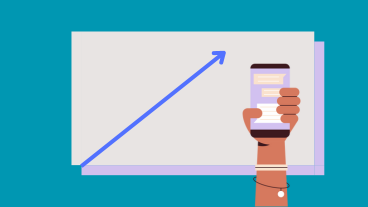If you are into an eCommerce business, you should already know how ads form an integral part of driving traffic to your web store.
Now consider this scenario. You run ads. Potential customers happen to see the ad, they are impressed and visit the product page on your site. But they just don’t have the money to buy the item right now or maybe they just bought a similar item and cannot afford to buy this one. Or right when they are about to checkout, they get a call and forget about the item. This happens all the time.
It turns out that only 2% of people visiting your site place an order. The rest of the visitors, if properly approached, give a much better chance at buying your stuff than another random person online finding your products and buying them.
That’s where retargeting helps. It focuses on running ads targeted at those visitors who have shown interest in your product previously.
What Is Retargeting?
Retargeting is a type of targeted marketing where advertisements are served to people who have previously visited your website or to established leads or contacts from your customer database.
Retargeting can be done via multiple methods and usually differ a bit in the implementation depending on the ads platform that you use.
The more people see the retargeted ads, the more likely they are to make a purchase. These ads pop up as reminders and push the potential customer into visiting your site again. Google claims that retargeting ads, when used along with your existing advertising strategies, can help you increase sales by 50%.
What Is The Difference Between Remarketing And Retargeting?
Remarketing and retargeting are more similar strategies, both working towards increasing conversion rates by focusing on individuals who have shown some interest in your product.
They are essentially the same and only differ in the way terminology is used in everyday practice.
Remarketing is usually used to refer to email campaigns that help in re-engaging customers through email content. These emails are usually reminder emails that say ‘Hey, you left your cart without checking out‘, notifications of stock availability, updates on new product versions, and newsletters on offers and so on. These are quite effective marketing strategies.
A study by AgilOne found that remarketing emails made customers feel appreciated and felt treated like a VIP.
On the other hand, the term retargeting usually refers to ad marketing campaigns and all the efforts taken to reach out to visitors to your online store.
How Does Retargeting Work?
Retargeting can be broadly classified into two strategies, on-site and off-site.
· Off-site
Off-site targeting focuses on the group of people who have not interacted with your site before but have similar behavior patterns as that of your existing customers. You can make use of offsite interactions like search terms used, similar product searches and so on.
Interactions with distributed content on social media apps can also be used to run targeted ads.
For instance, if a person has liked a promo ad of your product shared in a Facebook post, it means they have some interest in checking out your product.
· On-site
On-site interactions such as visiting your website, clicking on product pages, buying a product, searching through the product catalog and other actions taken on the site can be used to target the said visitor to increase conversion rates.
Retargeting in both the above ways makes use of a pixel-based or list-based targeting technique.
· Pixel-based
This is the most common method used to run retargeting ads. When someone visits your webpage, their basic user info can be collected via cookies and this information will then be used to place ads on other websites the user visits. The ads can be run with the help of a platform like Google Display Network or the Facebook ads platform.
These ad platforms will help you analyze the visitor’s behavior and will run ads on the other sites they visit. It is usually implemented with the help of a small, unobtrusive piece of JavaScript code placed on your website.
· List-based
List-based retargeting is used when you already have the contact details of your target audience in your database. This could be your existing customers, people who signed up into your site or your subscription lists. You can run retargeting email campaigns or use their Email addresses to run targeted ads on social media apps that use email addresses.
Retargeting Best Practices
There is always the right way to do a good thing and a million other ways to get it wrong. So, let’s not experiment with ad strategies and go with what experts think are best practices to retargeting.
· Segment your audience. Make use of behavior, time and existing customer information to properly segment your target audience and serve them with ads that are relatable to them.
· Make use of burn pixels. You buy something and still, you keep getting ads for the same product everywhere. Now, what used to be a reminder becomes a nuisance and understandably customers get annoyed and may report your ads. Besides, these ads also cost you money and have little chance of conversions.
· Use a burn pixel feature to un-tag users who have already made purchases.
· Optimize your landing pages and ads. Make it a good experience for the visitors and don’t let them get bored or tired of your ads. Use techniques like frequency capping, ad rotations and do a lot of alpha and beta testing before deploying your ads.
· Make the best use of cross-selling and up-selling. Use ads that show similar products and products that are usually bought together.
· Keep your target audience engaged with the help of sequential engagement campaigns. You can filter your visitors based on their level of engagement and focus on highly engaging customers to run your campaigns.
Limitations Of Retargeting
Some limitations you may face when running retargeting ads are briefly explained here.
In the case of pixel-based targeting, the critical requirement is the usage of cookies to collect information. Now the visitor can turn off Cookies usage and in those cases, you will not be able to run these ads for that user. The number of people that can be tracked and targeted simultaneously is also low as it is a timely operation.
· According to MediaMath, the matching rates between the email ids collected and corresponding social media profiles can vary from 70-80% on the high end and go as low as 20-30%. Hence, you should be able to prepare a large list before you get started with this type of retargeting.
· Other limitations like the extra effort required in coding and ad budgeting need also be considered. A simple cost-benefit analysis should help you see whether a retargeting campaign will work for you.
Conclusion
Retargeting works on a simple principle. When you have the information that someone is interested in your product why not take full advantage of it and get them to buy your products? And it works.
Most times, potential buyers need to be reminded at least 7 times to get them to finally make a purchase. Retargeting acts as a simple reminder and operates on efficiency as your target audience is further narrowed down and chances of conversion are increased considerably. Choose the right platform that works for you and optimize your ad strategy to accommodate retargeting.




